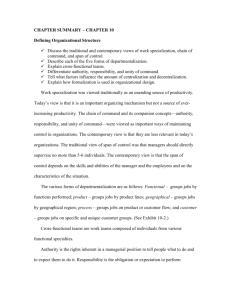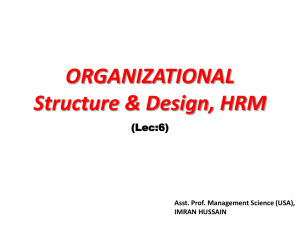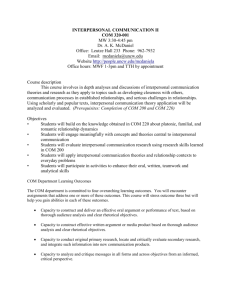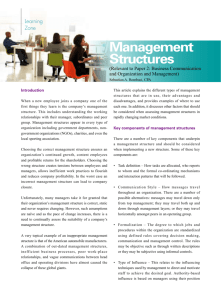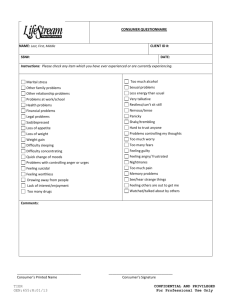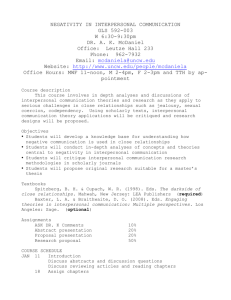Business Communication - FMT-HANU
advertisement
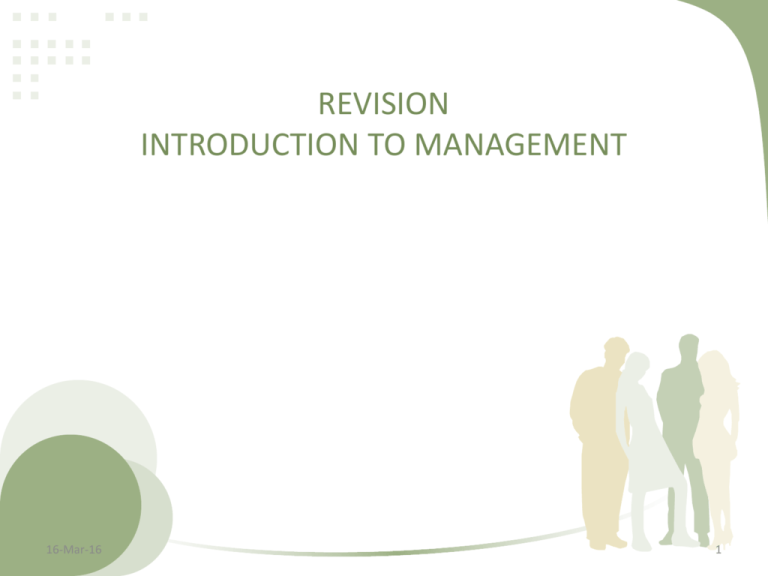
REVISION INTRODUCTION TO MANAGEMENT 16-Mar-16 1 Main Contents • Revision of the whole course • Revision scope • How to work on the final test – MCQs – Short answers – Case 16-Mar-16 2 Managerial Levels 16-Mar-16 1–3 Effectiveness and Efficiency in Management 16-Mar-16 1–4 Management Functions 16-Mar-16 1–5 Skills Needed at Different Management Levels 16-Mar-16 1–6 Characteristics of Organizations 16-Mar-16 1–7 Universal Need for Management 16-Mar-16 1–8 How an Organization’s Culture Is Established and Maintained 16-Mar-16 3–9 The External Environment 16-Mar-16 3–10 Organizational Stakeholders 16-Mar-16 3–11 To Whom is Management Responsible? 16-Mar-16 5–12 Overview of Managerial Decision Making 16-Mar-16 6–13 Types of Plans 16-Mar-16 7–14 The Strategic Management Process 16-Mar-16 8–15 Levels of Organizational Strategy 16-Mar-16 8–16 Corporate Strategies • Growth Strategy – Seeking to increase the organization’s business by expansion into new products and markets. • Types of Growth Strategies – Concentration – Vertical integration – Horizontal integration – Diversification 16-Mar-16 8–17 The BCG Matrix 16-Mar-16 8–18 Types of Competitive Strategies • Cost Leadership Strategy – Seeking to attain the lowest total overall costs relative to other industry competitors. • Differentiation Strategy – Attempting to create a unique and distinctive product or service for which customers will pay a premium. • Focus Strategy – Using a cost or differentiation advantage to exploit a particular market segment rather a larger market. 16-Mar-16 8–19 Forces in the Industry Analysis 16-Mar-16 8–20 REVISION EXAMINATION SCOPE Prepared by Nguyen Thi Thanh Hang 16-Mar-16 21 Chapter 9: Organizational Structure and Design • Organizational Structure – The formal arrangement of jobs within an organization. • Organizational Design – A process involving decisions about six key elements: • Work specialization • Departmentalization • Chain of command • Span of control • Centralization and decentralization • Formalization 16-Mar-16 10–22 Mechanistic versus Organic Organization • High specialization • Cross-functional teams • Rigid departmentalization • Cross-hierarchical teams • Clear chain of command • Free flow of information • Narrow spans of control • Wide spans of control • Centralization • Decentralization • High formalization • Low formalization 16-Mar-16 10–23 Contingency Factors • Structural decisions are influenced by: – Overall strategy of the organization • Organizational structure follows strategy. – Size of the organization • Firms change from organic to mechanistic organizations as they grow in size. – Technology use by the organization • Firms adapt their structure to the technology they use. – Degree of environmental uncertainty • Dynamic environments require organic structures; mechanistic structures need stable environments. 16-Mar-16 10–24 Selection of organizational structures (cont.) • Environmental Uncertainty and Structure – Mechanistic organizational structures tend to be most effective in stable and simple environments. – The flexibility of organic organizational structures is better suited for dynamic and complex environments. 16-Mar-16 25 Common organizational designs • Traditional Designs – Simple structure – Functional structure – Divisional structure • Contemporary – – – – 16-Mar-16 Team structure Matrix structure Project structure Boundaryless structure 26 Chapter 10: HRM • The importance of HRM • The HRM process • Current issues in HRM – – – – – 16-Mar-16 Managing downsizing Managing workforce diversity Managing sexual harrassment Work-life balance Controlling HR costs 27 Human Resource Management Process 16-Mar-16 12–28 Chapter 11: Managing Teams • The difference between group and work group • Group development stages 16-Mar-16 29 Chapter 14: Communication • • • • • • • What is communication? Four functions of communication The interpersonal communication process Interpersonal communication barriers Direction of communication flows Types of communication networks The grapevine 16-Mar-16 30 The Interpersonal Communication Process 16-Mar-16 11–31 Interpersonal Communication Barriers National Culture Language Filtering Emotions Interpersonal Communication Defensiveness 16-Mar-16 11–32 Information Overload Communication Flows U p w a r d 16-Mar-16 D o w n w a r d Lateral 11–33 Three Common Organizational Communication Networks and How They Rate on Effectiveness Criteria 16-Mar-16 11–34 Chapter 16: Motivating Employees • What is motivation? • Early theories – – – – Maslow Hierarchy of Needs McGregor’s Theory X and Theory Y Herzberg Two-Factor Theory Mcclelland’s Three-Needs Theory • Contemporary theories – – – – – Goal-setting theory Reinforcement theory Jog design theory Equity theory Expectancy theory • Motivating unique groups of workers 16-Mar-16 35 Chapter 16: Leadership • • • • Leader and leadership? Early leadership theories Contingency theories Contemporary views on leadership 16-Mar-16 36 Chapter 17: Controlling • • • • • What is controlling, purposes? Controlling systems The importance of controlling The control process Organizational performance? How to measure? (Organizational productivity and effectiveness) • Feedforward, concurrent, and feedback control • Tools for controlling organizational performance (financial controls, the balanced scorecard, information controls, benchmarking). 16-Mar-16 37 Exam Structure • 20 MCQs (20%) • 05 short answer questions (50%), choose from six questions • 1 case study (30%) 16-Mar-16 38 Case study • Clear ideas and presentation, straightforward, no repetition • Say what it is, then justify • Avoid describing the details in the case again. 16-Mar-16 39 Steps in writing 1. Brainstorm ideas 2. Group ideas under big categories/points 3. Write up with clear organization (introduction , body, and conclusion) 4. Don’t forget the transitional words (first, second, third, and so on) 5. Check again for errors (grammar, spelling, presentation, ideas overlap, etc.) 16-Mar-16 40 16-Mar-16 41
